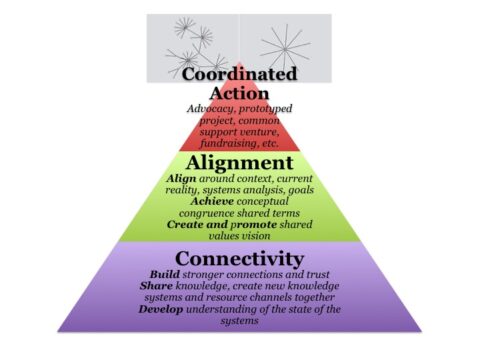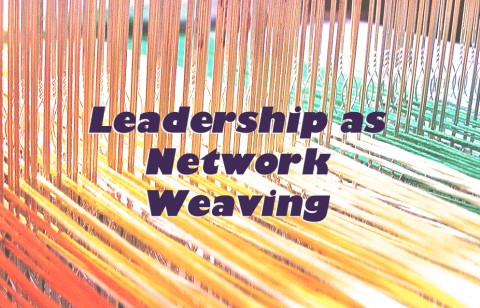Using the C-A-CA/P Framework to Evaluate a Policy Advocacy Network
January 22, 2021 Leave a comment
Over the past couple of years, I’ve worked with a state-wide health equity network, comprised of smaller coalitions, that has been looking at living into being more of a network in thinking and action. After some conversation and consideration, we decided to use a framework that derives from the writings of Madeleine Taylor and Pete Plastrik.
The Connectivity-Alignment-Coordinated Action/Production framework (see graphic above) lifts up three different network modes, through which value and impact is created. First of all, network value and impact is grounded at a fundamental level in creating connectivity, by building linkages and trust between key stakeholders and perhaps unusual bedfellows. This can be done by convening people; closing triangles, sharing stories, data and other forms of information; co-creating knowledge; learning together, etc. Part of the value of this connectivity is that it can lead to orthogonal thinking and bolster individual network participants’ efforts in the shared domain where the network is focused. What also might happen is self-organized action between those who are meeting one another for the first time or getting to know one another better.
“Healthy networks measure their impact, in particular by establishing the links between decentralized network action and outcomes.“
Up a level, networks may be compelled to create some kind of collective and aligned commitment or value proposition in the form of shared vision, values, public statements, etc. This can create greater impact/ripples, and provide additional value to individual participants and self-organized efforts, as they are more prone to head in the same general direction or with some kind of deeper shared understanding of context.
And then there are those instances when there is a call to some form of collective action, such as advocacy, a communications campaign, fundraising, or some other co-produced venture. This can happen even as smaller self-organized action continues (really, from a network perspective, most collective action should be about creating the conditions for those self-organized efforts, which is what is meant by “making the periphery the norm” in network building lingo).
With all of this in mind, after doing interviews, some observation, as well as evaluations and other documentation from the sub-networks of this state-wide advocacy network, a few patterns seemed to surface that suggested ways for the network to strengthen itself and leverage network effects.

Here is a list of what was surfacing as opportunities seen through the C-A-CA/P lens:
- In the calls that the network does with its members, there appeared to be more of a one-directional download of information from staff (the hub) to its members (the periphery). And in various documents there appeared to be some suggestion that people were not connecting except through the hub. Furthermore, an annual report said that state partners expressed a desire to know more about one another’s capabilities, constituencies, and connections. All of this suggested an opportunity for creating greater CONNECTIVITY, especially member-to-member.
- In an interview the observation was made that on membership calls there were often the same people speaking while others were silent. This suggested that greater CONNECTIVITY could be created for those who were less outspoken and silent. There appeared to be some correlation between those who were longer standing members (more outspoken) and those who were new to the network (more quiet).
- In assessments of meetings, comments were made that while people appreciate the great information and education they receive, they were also eager to meet, learn from and strategize with one another. This again suggested an opportunity to strengthen member-to-member CONNECTIVITY.
- Questions had come up about whether relationships with state and county lawmakers, behavioral health experts, and others might be better maximized for trust and information sharing. Another area to explore strengthening CONNECTIVITY to and among those stakeholder groups.
- Related to the above, while the network’s political capital was appreciated by many members, there were also questions about democratizing that power, and helping members to be more involved in the legislative process. This suggested that beyond creating greater CONNECTIVITY among members, there might be some opportunity to provide COORDINATION support to enhance access.
- “Clusters” of members in certain parts of the state had been mentioned in interviews and documents. It was observed that in one region, there is some evidence of people getting tighter and that in another region, organizations were using lists to get together. This lifted up the question about more intentional CONNECTIVITY and ALIGNMENT that the network might suggest or provide to those existing and other potential clusters to strengthen their advocacy work.
- An annual report identified some expressed concern about the challenge with creating alignment among collation partners on behavioral health priorities, and that “collective buy-in” and “intentional relationship building” will be key to establishing alignment. This is another reason to keep building that trust and CONNECTIVITY and also to explore actively facilitating ALIGNMENT around core priorities.
- It was shared in staff interviews that there have been questions from members about the network’s long-term vision – “Where are you trying to go?” This raised some possible opportunities to facilitate ALIGNMENT around a shared, guiding and galvanizing vision with members.
- Related to the above, the suggestion was raised around exploring he coalescing of sub-networks to consolidate and create more ALIGNMENT and COORDINATION between those separate coalitions.

And here is what was offered as a set of initial recommendations:
- Consider the points above and if there is agreement among staff about where to weave greater connectivity, facilitate alignment and/or coordinate activity in different domains. Specifically: Who needs to be better connected and what would that achieve? Would alignment around a shared vision and high-level goals be helpful? Who would need to be aligned?
- As these opportunities are identified, consider existing network (staff) capacity to provide weaving, facilitation and coordination support. Where and how might this capacity be added or developed?
- Think about ways to create greater connectivity within existing calls, meetings and trainings. For example, have a check-in question; invite people to share news, victories, needs; break people into pairs and smaller group discussions; create open space for people to explore interests and opportunities to work together.
- Consider creating a toolkit and perhaps a training for building relationships and maximizing connections in networks.
- Reach out to less out-spoken and newer coalition members to see if there is anything that would support their participation. Related to this, make sure there is an on-boarding process for new members so that they feel up-to-date and know how to participate.
- To gauge “network impact,” follow up with members to see what they do with the content, capacity and connections they get from calls. Are they able to leverage these for greater impact in their communities and regions to create “ripple effects”?
- Reach out to other networks to see how they go about democratizing power and opportunity in a network. In addition, look to other groups across the state to see how they are working with grassroots groups to mobilize around policy.
- Consider having an open conversation with member organizations about how to strengthen the sub-networks (coalitions) as a network. What ideas do they have? This might include giving them some overview of networks and network effects/impacts.
- Consider conducting an assessment to find and leverage “network champions.” Are there certain members who are particularly enthusiastic about and active in network activity and might be ambassadors for the collective work? Might they be more formally enlisted as network weavers?
- Consider the virtual tools currently used for keeping members connected (virtual meeting platforms, shared files and documents, archives, private group pages). Are they working? Are people taking full advantage of them? Is there additional value they are looking for that might be provided by other tools?
- Consider using a more formal network assessment to look for strengths and areas for growth and improvement in the network’s structures and practices. This could be conducted among staff alone and also include key partners. Examples include “Network Effectiveness: Diagnostic and Development Tool”, “Partnership Self-Assessment Tool” and “Network Health Scorecard.”